A bathroom shower is the place for bathing in the bathroom. Bathroom shower, spray the water through the small holes in the shower head. Shower increase the bathing comfortability and quality by mixing hot water and air. Showers are various types according to its functionality, design and installation.
According to the functionality, bathroom showers are mainly 9 types. Those are standard shower, handheld shower, rain shower, body/spray shower, steam shower, dual shower head, aerated shower, high-pressure shower, and thermostat shower. These shower types have specific advantages and disadvantages. Each shower type requires a specific space and layout. Among them, shower installation dimensions are the most important thing.
Before you choose a shower type, you should consider space and layout, budget, functionality, design, technical aspects, environmental considerations, safety, brand and warranty. These things always help you to choose the best bathroom shower for you.
What are the 9 Best Bathroom Shower Types?
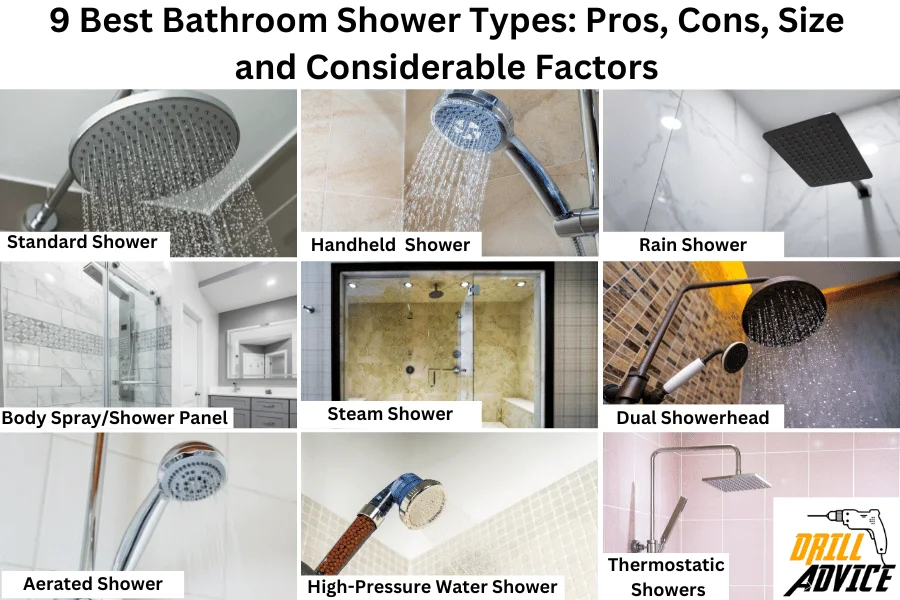
The 9 Best bathroom showers are;
- 1. Standard Shower
- 2. Handheld Bathroom Shower
- 3. Rain Shower
- 4. Body Spray/Shower Panel
- 5. Steam Shower
- 6. Dual Showerhead
- 7. Aerated Shower
- 8. High-Pressure Water Shower
- 9. Thermostatic Showers
Read More About – 7 Types of Bathrooms: Suitability, Includance Pros and Cons
1. Standard Shower
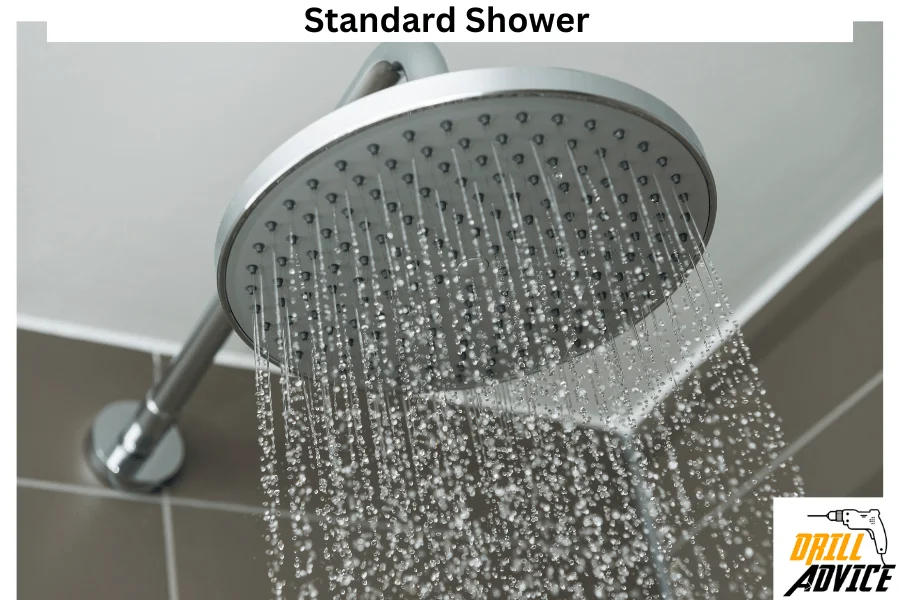
A standard shower is the basic and traditional bathroom shower. Standard bathroom shower can be easily mounted to the wall. Due to minimum parts standard showers are easier and quicker to install. It can be used easily with efficient cleaning and maintenance. Standard showers are generally less expensive.
Disadvantages of standard bathroom showers
- Standard bathroom showers has limited features
- Standard bathroom showers has Less versatility
- Standard bathroom showers offer a basic user experience
2. Handheld Bathroom Shower

A handheld bathroom shower has a detachable showerhead connected to a hose. Using that hose, you can control the spray of water direction as you need. Therefore, handheld showers are good for rinsing off, washing pets, or cleaning the shower itself. Handheld showers are highly recommended for kids and the disables. The handheld shower has an adjustable water spray setting from a gentle mist to a strong pulse.
Disadvantages of handheld bathroom
- Handheld showers are generally more expensive than standard showers
- Handheld showers need more maintenance: The hose and detachable parts can require more cleaning and are more prone to wear and tear.
- Handheld showers are complex to install.
3. Rain Shower
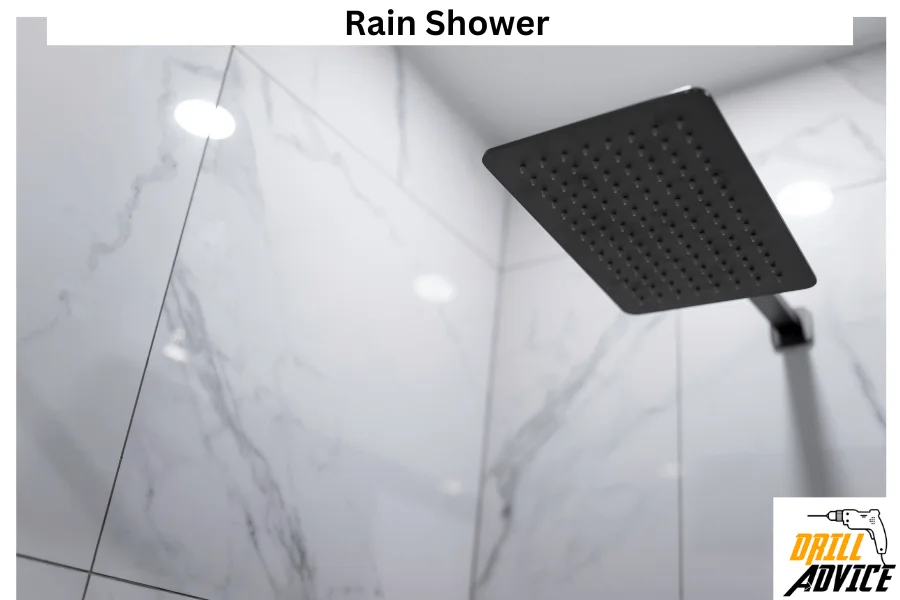
The Rainshower is designed to mimic the experience of standing in the rain. It features a large showerhead that is typically mounted on the ceiling or directly above you. A rain shower should be mounted 75 inches to 85 inches above the shower floor. The splash diameter of the rain shower is about 24 inches to 06 inches wide. The rain shower should be 24 inches away from the wall. Rain showers provide a gentle and relaxing water flow that can make you feel like you’re in a spa.
Disadvantages of a rain shower
- Rain showers are expensive for both unit and installation.
- Rainshower consumes more water than the standard shower
- Complex installation under the ceiling.
4. Body Spray/Shower Panel

A Body Spray/Shower Panel is essentially a wall-mounted panel with multiple water jets. Unlike a standard showerhead that sprays water from above, this system has jets positioned at various heights along the panel to target different areas of your body.
- Lower Jets: Position these around knee height, roughly 18 to 24 inches from the floor.
- Middle Jets: These should aim at your lower back or hips, usually 36 to 48 inches from the floor.
- Upper Jets: Place these at shoulder height, approximately 54 to 60 inches from the floor.
Body Spray/Shower panel provides full body coverage fo the water. Its water pressure can be customized according to your preferences. This is an efficient and quick way to wash your body in a time period.
Disadvantages of Body Spray/Shower Panel
- Body Spray/Shower Panels are expensive bathroom showers.
- Body Spray/Shower Panel has a complex installation
- Body Spray/Shower Panel requires more space
- Body Spray/Shower Panel has more maintenance
5. Steam Shower

A steam shower is a sealed enclosure equipped with a steam generator that turns water into steam, filling the space with moisture. When you turn on the steam function, and the generator heats water to produce steam. The steam then fills the sealed shower enclosure. You can still have a regular shower in it.
The steam helps relax your muscles and mind. Steam opens up your pores and cleanses your skin. It can help clear your sinuses and improve breathing.
- Ceiling Height: Keep it between 7 and 9 feet.
- Shower Size: At least 3 feet by 3 feet for a comfortable experience.
- Distance from Steam Outlet: Stand at least 12 inches away to avoid burns.
Disadvantages of Steam showers
- Steam showers are expensive than regular showers, both in installation and energy use.
- Maintenance: You’ll need to clean it more often to prevent mold.
- Space: Requires a larger area, which might not be feasible for smaller homes.
- Health Risks: Not recommended for people with certain health conditions like heart issues.
6. Dual Showerhead
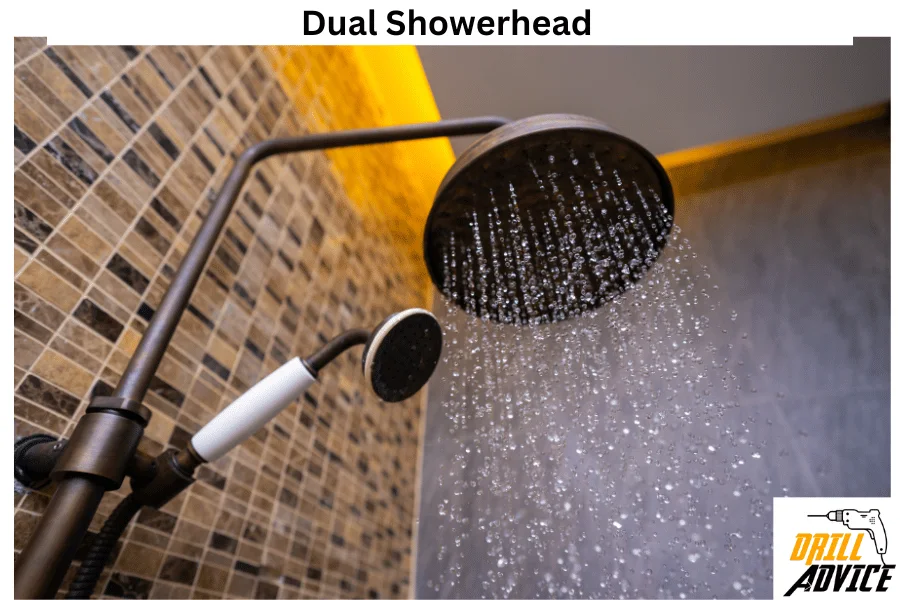
Dual shower heads consist of two shower heads in one unit. In dual shower heads, one shower head is fixed and the other one is handheld. Some dual showerhead units have two fixed heads positioned at different angles. The idea is to give you more control and customization over your shower. Due to the dual heads, the shower can cover more body area at once. You can shower with your partner comfortably with using the dual shower heads. Before choosing a dual shower head, you should think about the water pressure, installation, and space to be needed.
Disadvantages of Dual Shower Heads
- Dual shower heads consume more water
- Dual shower head can increse the water bill
- Difficult to fix, maintain and clean
7. Aerated Shower
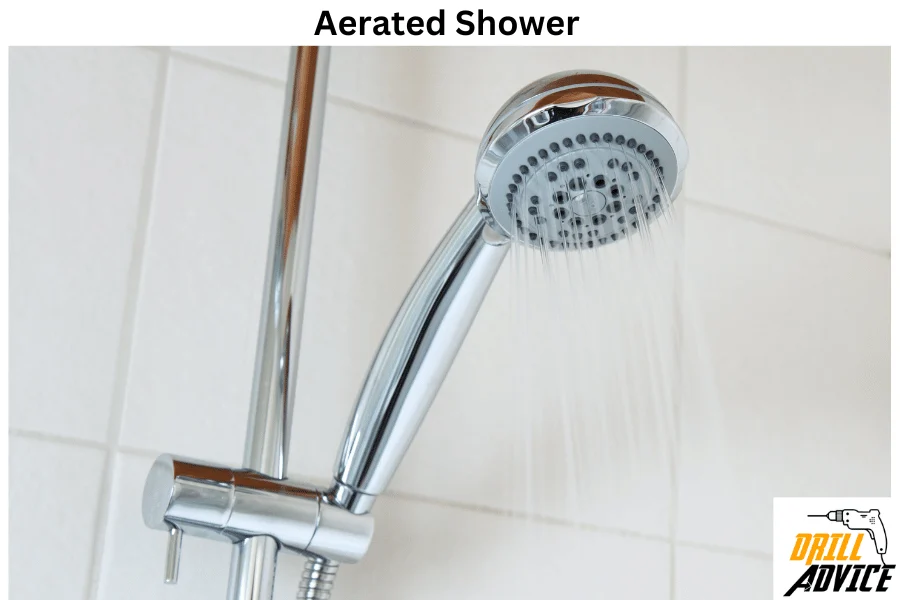
An aerated shower outputs a water and air mixture together. Aerated shower can mix air with water to create a softer, mist-spray. Inside the showerhead, a small device mixes air with water. This process increases the volume of the water droplets, making them lighter and more spread out. One of the biggest advantages is water conservation. Because the water droplets are filled with air, you use less water overall. This can be a game-changer for your water bill and for the environment.
The air-infused water droplets are softer and less harsh on the skin. It provides a more comfortable shower experience. Aerated showers often offer more consistent water pressure, which can be a relief if your home has issues with fluctuating pressure.
- Height: Aim for a height of about 80 inches from the floor to the showerhead.
- Distance from Wall: The showerhead should be at least 12 inches away from the wall. This distance allows the aerated water droplets to spread out and provide a fuller shower experience.
Disadvantages of Aerated Showers
- Need regular cleaning because the air holes can get clogged easily. Therefore, it requires regular cleaning to maintain optimal performance.
- Temperature Decrease – When the water is mixed with air, it can cool down more quickly. This might require you to use more hot water, which could negate some of the water-saving benefits.
- Cost: Aerated showerheads can be more expensive upfront, although you may recoup some of this cost through water savings over time.
8. High-Pressure Water Shower

A high-pressure shower outputs water at a higher force compared to standard showerheads. High-pressure showerheads use a specific design to focus water flow more powerfully. High-pressure power allows you to switch between a softer and more forceful spray as you wish.
A high-pressure shower is suitable for effective cleaning. The strong water flow makes it easier to rinse off soap and shampoo easily and effectively. Using a high-pressure shower users can have a refreshing experience and water massage for the muscles easily.
Height: A height of around 80 inches from the floor to the showerhead is standard for most showers.
Distance from Wall: Keep the showerhead at least 12 inches away from the wall to ensure the water spray has room to disperse properly.
Disadvantages of High-Pressure Showers
- High-pressure showers consume more Water.
- High-pressure showers can increase the plumbing stress; therefore, pressure can be increased, and it will lead to wear and tear over time.
- It is not good for sensitive skin users, and medical warned people.
9. Thermostatic Showers
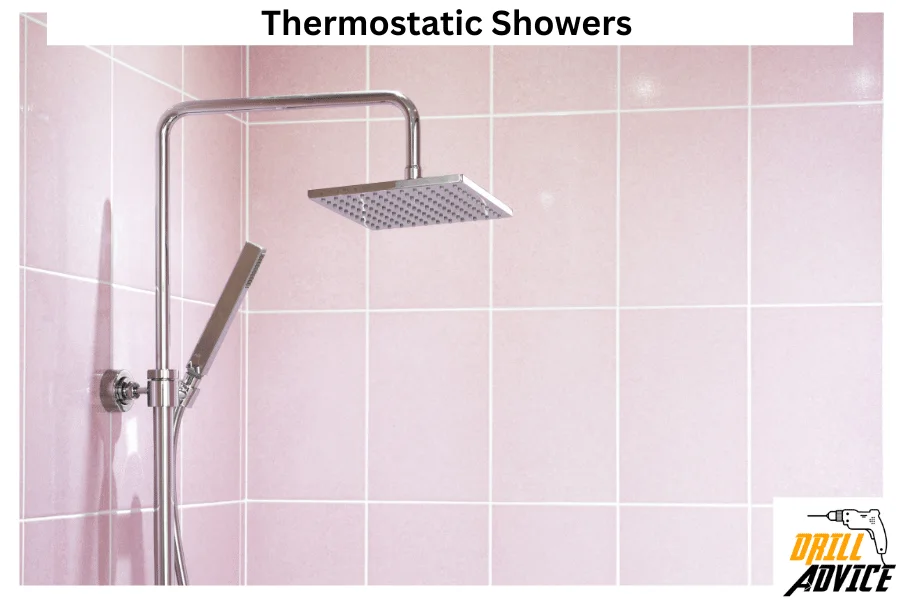
A thermostatic shower is designed to maintain a constant water temperature. The output water temperature of the thermostatic shower will not be varied with the home water consumption. A thermostatic shower valve controls the water temperature. This valve mixes hot and cold water to your pre-set temperature and maintains it by continually adjusting the mix. Thermostatic showers can prevent of scalding. Hence it is good for children, disabels and adults.
- Height: Aim for a height of about 80 inches from the floor to the showerhead for a comfortable shower experience.
- Distance from Wall: A distance of at least 12 inches from the wall allows for optimal water flow and minimizes splashing.
Disadvantages of Thermostatic Showers
- Thermostatic showers are more expensive to purchase and install compared to traditional showers.
- Thermostatic showers need skill and experience for installation.
- Thermostatic showers have expensive maintenance and part replacement.
What Should Consider Before Choosing a Bathroom Shower?
Before choosing a bathroom shower, you should consider space and layout, budget, functionality, design aesthetic, technical aspects, environmental considerations, safety. brand and warranty of the bathroom shower. These considerable factors will help you choose the best bathroom shower for you.
- Space and Layout of the Shower of the Bathroom Shower – Consider the size of your bathroom and how much space you have available for a shower. Additionally, think about the placement of the shower in relation to other fixtures like the toilet and sink. Make sure there is enough space in the room for comfortable movement and access to door swing and ceiling height.
- Budget of the Shower of the Bathroom Shower – When you choose your bathroom shower, you should determine your budget by considering the initial cost of the shower itself, installation costs, and any ongoing maintenance or operational expenses. You should find an affordable budget, easy.
- The functionality of the Bathroom Shower – When you choose a bathroom shower, you should know its type, whether the shower is a wall-mounted model a luxurious steam model. According to your preferences, you should choose it. And also, you should consider the water pressure and the ease of the use of the shower before you choose it.
- Design and Aesthetic of the Bathroom Shower – Consider the style that matches your taste and complements your existing bathroom decor. Choose a shower made from high-quality materials that are both durable and visually appealing. Additionally, explore different showerhead designs that offer various spray options to enhance your showering experience.
- Technical Aspects of the Bathroom Shower – Before you choose a bathroom shower ensure that the plumbing is compatible with the shower system you choose. Proper drainage is essential to prevent any water damage or pooling. Ventilation is crucial to prevent mold and mildew growth. Lastly, consider the capacity and efficiency of your water heater to ensure a consistent supply of hot water.
- Environmental Considerations of the Bathroom Shower – When choosing a bathroom shower, consider its water efficiency. Look for showers that are designed to conserve water without compromising on performance. Look for showerheads with a WaterSense label, as they meet strict water efficiency standards. Additionally, consider the energy use of the shower. Opt for showers that are energy-efficient and utilize technologies such as low-flow aerators or LED lighting.
- Safety of the Bathroom Shower – Safety should be a top priority when selecting a bathroom shower, especially if you have family members with mobility issues or disabilities. Consider the accessibility of the shower, ensuring it is easy to enter and exit. Look for features like grab bars, non-slip surfaces, and adjustable showerheads to accommodate various needs.
- Warranty and Brand of the Bathroom Shower – Before choosing a bathroom shower, you should research different brands and read customer reviews to ensure you choose a trusted and reputable brand. Additionally, check the warranty offered by the manufacturer. A solid warranty provides peace of mind and protects you from any potential defects or issues with the shower. Look for warranties that cover both the shower unit and its components.
